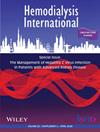Microbiologic outcomes of ceftazidime-avibactam dosing in patients with sepsis utilizing renal replacement therapies
Abstract
Introduction
The suggested dose of ceftazidime-avibactam (CEF/AVI) in patient with multidrug resistant organisms and utilizing renal replacement therapies (RRTs) is not validated in clinical studies. The objective of this study was to evaluate the microbiologic cure of bacteremia and pneumonia using the recommended CEF/AVI dosing in patients utilizing RRT.
Methods
A retrospective observational study conducted at our institution between September 15, 2018 and March 15, 2022. The primary end point was to determine the microbiologic cure. The secondary end points were the clinical cure, 30-day recurrence, 30-day all cause mortality.
Results
Fifty-six patients met the inclusion criteria, 36 (64.3%) were males, the median age was 69 (59.5–79.3) years, and the median weight was 69 (60–83.8) kg. Pneumonia represented 34 (60.7%) of infections. Microbiologic cure was achieved in 32 (57%) subjects. However, clinical cure was achieved in 23 (71.9%) patients in the microbiologic cure group versus 12 (50%) in the microbiologic failure group (p = 0.094). The 30-day recurrence occurred in 2 (6.3%) patients in the microbiologic cure group versus 3 (12.5%) in the microbiologic failure group (p = 0.673). Further, the 30-day all-cause mortality was 18 (56.3%) versus 10 (41.7%) in both groups respectively (p = 0.28). The most used dose in patients utilizing continuous veno-venous hemofiltration (CVVH) was 1.25 g q8h, while the dose was 1.25 g q24h in those who utilized intermittent hemodialysis (IHD). The multivariate logistic regression indicated that bacteremia (OR 41.5 [3.77–46]), Enterobacterales (OR 5.4 [1.04–27.9]), and the drug daily dose (OR 2.33 [1.15–4.72]) were independently associated with microbiologic cure.
Conclusion
Microbiologic cure of ceftazidime-avibactam in patient utilizing CVVH and IHD is dependent on bacteremia diagnosis, the drug daily dose, and bacterial species. These findings need to be replicated in a larger prospective study, with no recommendations in those utilizing RRT.

 求助内容:
求助内容: 应助结果提醒方式:
应助结果提醒方式:


